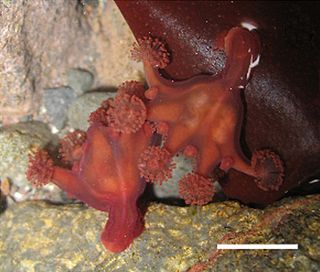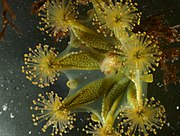
Cnidaria is a phylum under kingdom Animalia containing over 11,000 species of aquatic animals found both in freshwater and marine environments, predominantly the latter.

Jellyfish and sea jellies are the informal common names given to the medusa-phase of certain gelatinous members of the subphylum Medusozoa, a major part of the phylum Cnidaria. Jellyfish are mainly free-swimming marine animals with umbrella-shaped bells and trailing tentacles, although a few are anchored to the seabed by stalks rather than being mobile. The bell can pulsate to provide propulsion for highly efficient locomotion. The tentacles are armed with stinging cells and may be used to capture prey and defend against predators. Jellyfish have a complex life cycle; the medusa is normally the sexual phase, which produces planula larvae that disperse widely and enter a sedentary polyp phase before reaching sexual maturity.

In zoology, a tentacle is a flexible, mobile, and elongated organ present in some species of animals, most of them invertebrates. In animal anatomy, tentacles usually occur in one or more pairs. Anatomically, the tentacles of animals work mainly like muscular hydrostats. Most forms of tentacles are used for grasping and feeding. Many are sensory organs, variously receptive to touch, vision, or to the smell or taste of particular foods or threats. Examples of such tentacles are the eyestalks of various kinds of snails. Some kinds of tentacles have both sensory and manipulatory functions.

Medusozoa is a clade in the phylum Cnidaria, and is often considered a subphylum. It includes the classes Hydrozoa, Scyphozoa, Staurozoa and Cubozoa, and possibly the parasitic Polypodiozoa. Medusozoans are distinguished by having a medusa stage in their often complex life cycle, a medusa typically being an umbrella-shaped body with stinging tentacles around the edge. With the exception of some Hydrozoa, all are called jellyfish in their free-swimming medusa phase.

Stauromedusae are the stalked jellyfishes. They are the sole living members of the class Staurozoa and belong to the medusozoa subphylum of Cnidaria. They are unique among medusa jellyfish in that they do not have an alternation of polyp and medusa life cycle phases, but are instead interpreted as an attached medusa stage. With a lifestyle more resembling that of polypoid forms. They have a generally trumpet-shaped body, oriented upside-down in comparison with other jellyfish, with the tentacles projecting upwards, and the stalk located in the centre of the umbrella.

Chrysaora hysoscella, the compass jellyfish, is a common species of jellyfish that inhabits coastal waters in temperate regions of the northeastern Atlantic Ocean, including the North Sea and Mediterranean Sea. In the past it was also recorded in the southeastern Atlantic, including South Africa, but this was caused by confusion with close relatives; C. africana, C. fulgida and an undescribed species tentatively referred to as "C. agulhensis".

Hydroidolina is a subclass of Hydrozoa and makes up 90% of the class. Controversy surrounds who the sister groups of Hydroidolina are, but research has shown that three orders remain consistent as direct relatives: Siphonophorae, Anthoathecata, and Leptothecata.

Sea anemones are a group of predatory marine invertebrates of the order Actiniaria. Because of their colourful appearance, they are named after the Anemone, a terrestrial flowering plant. Sea anemones are classified in the phylum Cnidaria, class Anthozoa, subclass Hexacorallia. As cnidarians, sea anemones are related to corals, jellyfish, tube-dwelling anemones, and Hydra. Unlike jellyfish, sea anemones do not have a medusa stage in their life cycle.

Cydippida is an order of comb jellies. They are distinguished from other comb jellies by their spherical or oval bodies, and the fact their tentacles are branched, and can be retracted into pouches on either side of the pharynx. The order is not monophyletic, that is, more than one common ancestor is believed to exist.
Calvadosia cruxmelitensis is a stalked jellyfish which inhabits the intertidal and sublittoral zones of rocky coasts in south-western England and the Atlantic coast of Ireland.

Haliclystus is a genus of stalked jellyfish that contains 11 species and one nomen nudum. It is the largest genus in the order Stauromedusae. Members of this genus are found in the Pacific, Atlantic, Indian, Arctic, and Southern oceans. Two members of this genus, Haliclystus kerguelensis and Haliclystus antarcticus, are found in the Southern hemisphere only. The remaining 9 members are found in the Northern hemisphere only.

Haliclystus auricula is a stalked jellyfish found in the Northern hemisphere. It is the type species for its genus.
Lucernaria janetae is an exceptionally large stalked jellyfish discovered on deep-sea hydrothermal vents on the East Pacific Rise in 2003 and described in 2005.

Haliclystus antarcticus is a stalked jellyfish which lives on rocky shore lines in the Southern hemisphere.

Haliclystidae is a family of stalked jellyfish in the order Stauromedusae.

Lipkea is a genus of stalked jellyfish. It is the only genus in the monotypic family Lipkeidae. Lipkea species lack tentacles at the end of their bell.
Kyopoda is a genus of stalked jellyfish, It has only one species in the genus, Kyopoda lamberti, and is in turn the only genus in the family Kyopodiidiae.

Manania handi is a species of stalked jellyfish found in the Pacific Ocean along the west coast of North America. This species can be found in shallow waters at low tide on soft substrates such as seagrass (Phyllospadix), but the related M. gwilliami have also been recovered at depths of >10 metres. This may reflect that intertidal specimens represent the fringes of a population that is typically more commonly found in the subtidal zone.

Haliclystus sanjuanensis is a species of small (~4 cm) stalked jellyfish found in the Pacific Ocean along the west coast of North America. This species can be found in shallow waters at low tide on soft substrates such as seagrass (Phyllospadix). A variety of colour morphs can be found ranging from yellow-green to red. Haliclystus sanjuanensis remains undescribed officially, despite sequence data establishing it as a distinct taxon.

Clava is a monotypic genus of hydrozoans in the family Hydractiniidae. It contains only one accepted species, Clava multicornis. Other names synonymous with Clava multicornis include Clava cornea, Clava diffusa, Clava leptostyla, Clava nodosa, Clava parasitica, Clava squamata, Coryne squamata, Hydra multicornis, and Hydra squamata. The larvae form of the species has a well developed nervous system compared to its small size. The adult form is also advanced due to its ability to stay dormant during unfavorable periods.




















